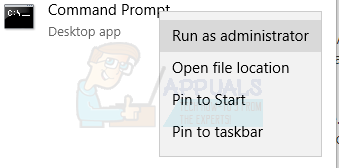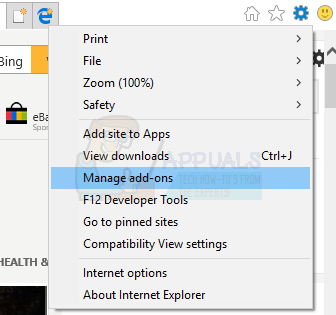Fix: api-ms-win-service-core-L1-1-0.dll is missing
The error “api-ms-win-core-path-l1-1-0.dll is missing” and “This program could not start because the library api-ms-win-service-core-L1-1-0.dll is missing.” has occurred on a number of Windows PCs. This error keeps popping up on Windows desktops, and for some other users, the issue seems to occur when Internet Explorer is started.
This article provides you with means to solve this issue which includes, re-registering the said dll file, performing an sfc scan, fixing corrupted user profiles, creating a new user account and disabling the Microsoft Lync Add-On in Internet Explorer.
Be sure to try out subsequent methods if the previous one don’t work.
Method 1: Re-registering the Faulty DLL
- Open the Start menu and type cmd. Right click on the Command Prompt icon and click on ‘Run as Administrator’. Accept the UAC prompt when it comes up.

- In the command prompt, type the following commands, and hit Enter after each command:regsvr32 /u api-ms-win-core-path-l1-1-0.dllregsvr32 /i api-ms-win-core-path-l1-1-0.dll
- Restart your PC and monitor your PC or try launching Internet Explorer to check if the error message has disappeared.
Method 2: Disabling Microsoft Lync Add-On
Microsoft Lync (Currently Skype for Business) is an enterprise level instant-messaging client used with Skype. If you still have Microsoft Lync or now Skype for Business, you should try disabling the Lync Add-On on Internet Explorer using the following steps.
- Open Internet Explorer by clicking on the “e” icon on the taskbar or pressing the start button, typing IE and pressing Enter.
- Click on the settings (gear) icon on top of the window and select Manage add-ons.

- In the Manage Add-ons window, select the Lync add-ons namely Lync Browser Helper and Lync Click to Call and then click the Disable button at the information section located at the bottom of the window.

- Monitor your PC or restart Internet Explorer to check if the error message has disappeared.
Method 3: Perform a System Restore
Some users were able to get this issue solved by performing a system restore. This guide teaches you how to perform a system restore. If you use any version of Windows than Windows 10, jump the the “Restoring the System using System Restore Point:” section of the guide.
Method 4: Running an SFC Scan
- Open the Start menu and type cmd. Right click on the Command Prompt icon and click on ‘Run as Administrator’. Accept the UAC prompt when it comes up.
- In the command prompt, type the following commands, and hit Enter after each command:sfc /scannow

This will run a system file check and repair all corrupt system files on your computer.
- Restart your PC and monitor your PC or try launching Internet Explorer to check if the error message has disappeared
Method 4: Create a New User Account
You should create a new user account and check if the you experience the same issue. You’ll find how to do that from here.